IMPACT ASSESSMENT
Comprehensive Guide to Business Impact Analysis
Table of Contents
Introduction
There is no shortage of risk in the business environment. This is why a business impact analysis is essential, no matter your market. Good business practice is finding a way to shockproof your business from unexpected events.
In this comprehensive guide to business impact analysis, we have tried to simplify the process for you. What we have put together here is a one stop shop for all things impact assessment. We will walk you through the definitions, the types, the advantages and the impact assessment process.
The reality is there is no perfect system that can mitigate every foreseen and unforeseen risk. However, a business impact analysis can insulate your business and set you on a path towards full recovering much quicker.
So, if you are wondering what the best approach is, this guide has you covered. Forearmed is forewarned. Let’s get down to business
What is Impact Assessment?
We define impact assessment as a fact-finding mission that seeks to look for and address root causes that change certain aspects of the business before they happen.
It is structured by certain deliberate steps or processes that look at the implications of certain actions on people, business and the environment.
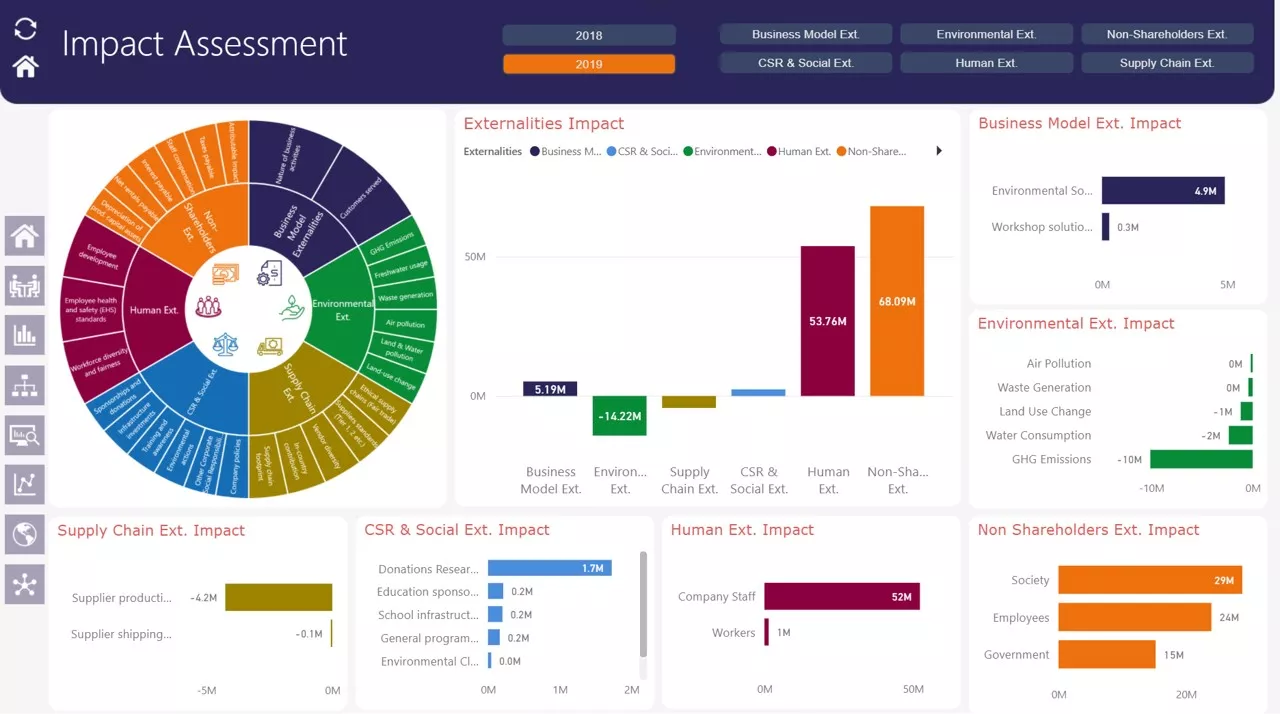
Impact assessment seeks to answer the following questions:
- What are the significant changes that certain interventions bring to the business?
- What are the effects of these changes or interventions on a business and on its performance?
- What are the long-term and short-term effects of these events?
In addition to these questions, an impact assessment looks at the broader ecosystem or market that the business operates in.
The process of impact assessment involves the isolation of activities or events that are the most likely to affect the business, its finances and operations. On an external scale, the impact analysis looks at the social, economic and environmental significance of these events and evaluates their effects.
This provides businesses with correct and accurate data that can be used for decision making. A bonus of this assessment is that it promotes transparency in the organization. Essentially, an impact assessment is akin to a car service appointment or your annual health check-up.
Impact assessment takes a holistic approach in assessing the performance of businesses. Recognizing that social and environmental factors cannot be ignored when trying to mitigate risk.
What is change impact assessment?
Change impact assessment on the other hand is a narrower investigation. It is defined as the steps or actions that management takes to analyze the impact of a change within the organization.
These steps are usually a series of tasks that collect data on the degree of impact the events will have on the operations and survival of the business.
Pertinent questions that change assessment tasks must answer include;
- What are the social implications of this change? How many areas, people or regions will be impacted?
- What has changed?
- When or how will these groups or regions be impacted?
- Why is this change affecting these areas and groups of people, and how severe is the impact?
When a company implements or plans to implement changes to its policies, values, organizational culture, branding, systems or technology, there are certain groups and areas of business that will be affected. Everyday examples of this are:
- When a company opens up shop in a new country
- When the organization expands its market and introduces new products
A change impact assessment is a critical piece in the puzzle, and it is an effective impact analysis tool that is used as a foundation for the other parts of the business impact analysis process.
Impact assessment versus impact evaluation
Often these two terms are thought to mean the same thing. However, they mean two different processes.
As we have stated before, impact assessment is the investigation on the effects of change to a business. Impact evaluation on the other hand analyses the adequacy of the design. Impact evaluation focuses on:
- The suitability of the design and process of the intervention
- The appropriateness of the cost
- The competence of the intervention and its implementation
- Unforeseen effects of the change
Essentially, an impact evaluation is a post- impact assessment analysis aimed at assessing the effectiveness of the impact analysis plan in insulating the business from risk. By using impact evaluations, management can implement good well-timed and cost-effective decisions to carry out the business mandate.
Business impact analysis versus Impact assessment
Though very closely connected and often used simultaneously, business impact analysis and impact assessment are different
They are both stages in the same process, but one follows the other. The table below shows their major difference:
Traditional impact analysis versus Simfoni's Impact assessment
ESG ratings available on the market are mostly qualitative; subject to debate, manipulation, and often contradict each other. Quantitative impact assessment is essential to measure, control and compare the impact in $ terms on the company’s ecosystem. Simfoni developed a comprehensive impact assessment framework based on 6 pillars
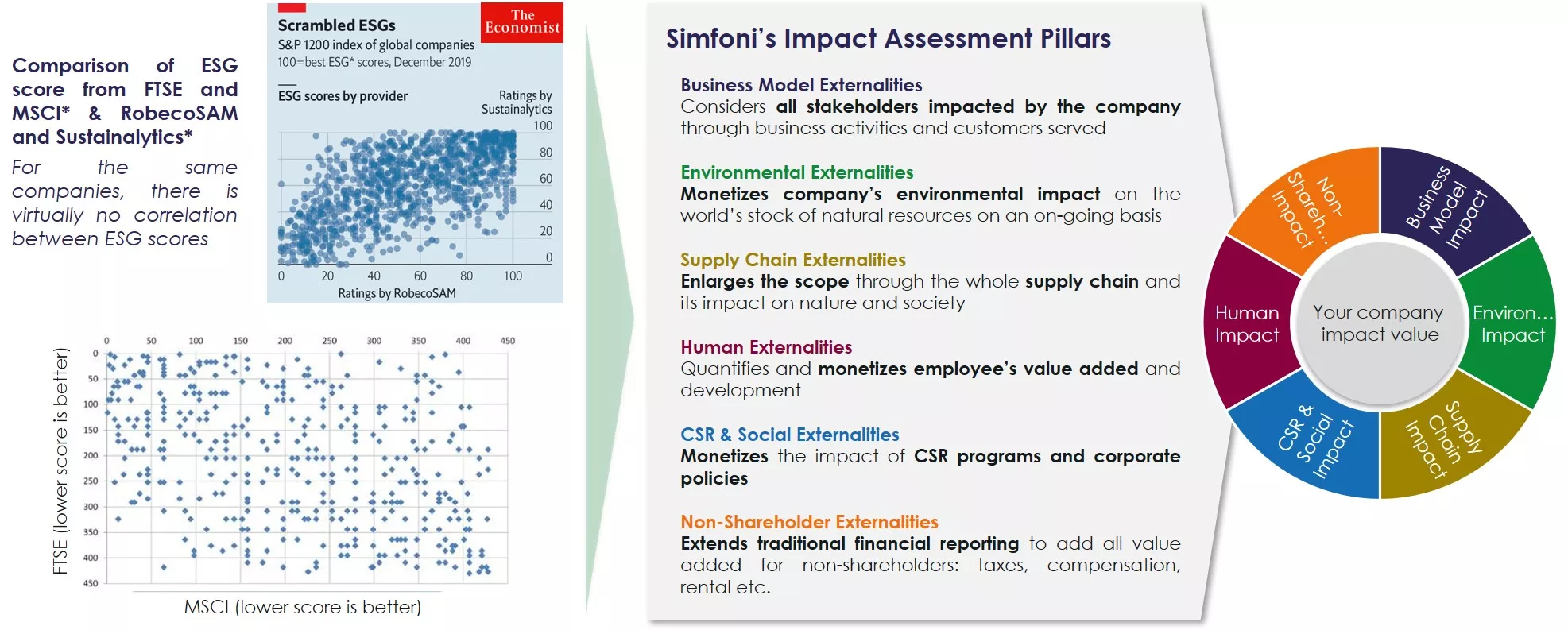
The impact of certain decisions, policies or programs on businesses can be identified in the following occurrences for the sake of developing a business impact analysis:
- Mergers or de-mergers
- Upgrading the technology used by the business
- Downsizing
- Rebranding
- Expansion such as franchising or licensing
- Natural events
- Damage to property such as buildings, equipment or infrastructure
- Health pandemics
- Breakdown of machinery
- Interrupted supply chain
- Data loss
- Security and cyber security issues
- External or Internal theft
- A change in the production line
We have already addressed the factors that are put into consideration when looking at impact assessment above. So naturally we have to breakdown what a business impact analysis report factors in its data.
Consider the following data as examples of what a business analysis report should cover:
- Lost income and reduction in sales
- Expense increase
- Loss of market share and customer base
- Customer dissatisfaction
- Contractual penalties
- Fines
- Delayed sales or delayed income
- Timing of the disruptive change or event
- Damage to property if the disruption is of a physical nature
Why does your business need a business impact analysis strategy? The answer is simple. It is a detailed plan that can insulate your business from various things.
The purpose of business impact analysis is:
- To determine the impact that an organizational change will have
- To be prepared against the worst that Mother Nature can throw at you
- To mitigate the risk that technological disruptions may cause
- To improve company security
- It is a way to take proactive action in preparation of operational and financial disruptions
- It improves and facilitates business continuity
What is included in impact assessment?
The internet is full of varying definitions of what impact assessment factors need to be included. The arguments range from a very narrow and focused view to a very broad spectrum of factors that influence change.
For businesses, it is important that your impact assessment includes as many factors as possible. This is especially true because the world is now intricately connected. A sneeze in a different part of the world can make another region catch a cold.
The diagram below shows you an example of some of the factors that your business should incorporate in its impact assessment strategies.
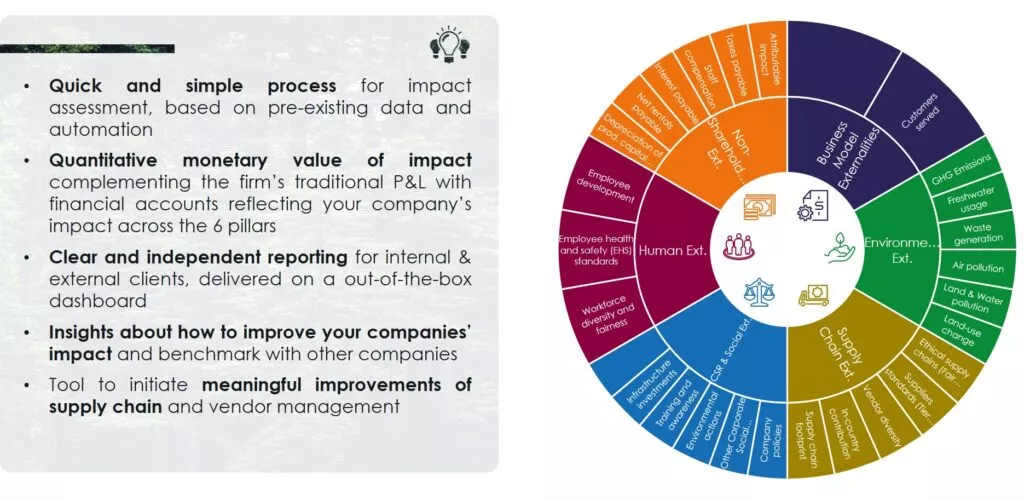
Why is impact assessment important?
Every action has an equal and opposite reaction. This law coined by Newton rings true for every business. If your business is ignoring this principle, then you are walking blindly. Business impact analysis aside from risk mitigation helps an organization make well thought out and planned decisions.
For large-scale or multi-national companies they must strike a balance between the different types of impact, the different levels, and the short term and long-term effect of any negative or positive intervention. That is why planning ahead as much as possible is important.
Simfoni helps you to change the way you see firm performance:-
Strive for long term value creation for all stakeholders
Stakeholders of your firm (shareholders, employees, customers, suppliers, investors, authorities and the public) are increasingly interested in your organization’s impact and implications. Climate change and societal issues cannot be ignored anymore, and COVID has further accelerated the trend.

What is the role of impact assessment?
It is nearly impossible to list every worst-case scenario that might occur. However, an impact assessment will make your business better prepared. Aside from this, impact assessment has a bigger role to play in the sustainability of your business.
The role of impact assessment is simple;
- Impact assessment helps the business to understand the changes that can occur and plan ahead to mitigate or maximize on the negative and positive disruptions.
- Impact assessment improves accountability to the business stakeholders such as the shareholders, employees, donors, partners, customers, partners, supporters and beneficiaries.
- It gives a transparent look at the sustainability of the business as a tool towards investigating the role and success of the business in the ecosystem.
- The impact assessment report is used to take a deeper look at the effectiveness of the policies, practices, strategies and culture of the business in the overall global network.
Why Is Impact Assessment Important
While an impact assessment report can vary in the factors that it considers, the general importance of the process is the same regardless of the market that your business is in.
Typically, there are three reasons why an impact assessment is so important.
1. It safeguards business goodwill
How many times have you seen a good brand with an excellent reputation lose it all because of a mistake either by embarking on a tone deaf campaign or by producing a product that is not taken well by its customers?
Reputation is everything, and cutting corners is often an expensive endeavor. That said, some things are not in your control. What is the best decision to make when a shipment of your product worth millions of dollars suffers up to 75% of damage whilst in transit?
An impact assessment will look at such scenarios before they occur, and you can make the best decision based on actual data.
2. Loss of Income Mitigation and Business Recovery
The purpose of any business is to make profit and mitigate loss. However, the world of business is not entombed in a safe cocoon where nothing bad never happens.
An example of a catastrophic event is a big natural disaster occurring before a large sale event like Black Friday or a big seasonal holiday and affecting your business operations.
In this case, if you have an impact assessment and a comprehensive business analysis, you would have identified that such events can take place. Your team should have proper recovery plans in place that can kick in and salvage the situation.
The elimination of confusion in the organization regarding which areas to priorities recovery will mitigate the loss of income
If a less extreme loss or risk occurs, then the impact assessment report and evaluation should have envisioned a version of such a scenario. This will help the business reduce the amount of money spent if contingency plans are in place.
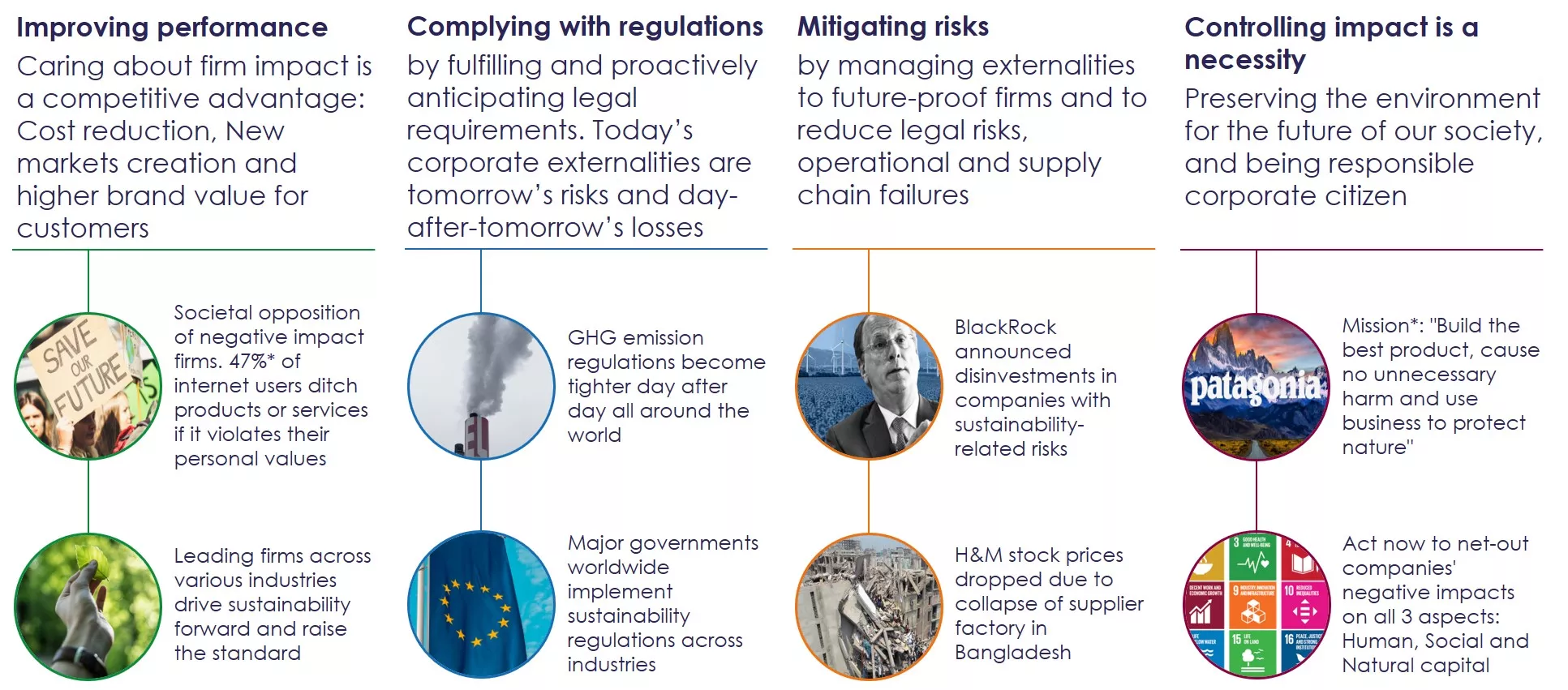
3. You get business operation information from the source
The people who know the most about how a change or an event will impact the business are your employees and stakeholders.
An impact assessment will help an organization retrieve information from the very people who are likely to spot an issue or a missing link in the system.
Benefits and Advantages of Impact Assessment
1. There is a business recovery plan in place
An impact assessment process produces a report that is based on data collected by various impact assessment methodologies. What this process achieves in an organization is beyond essential.
The business will be in possession of information that details a business continuity plan in the event of a change in circumstances. This means that the business has a starting point instead of you trying to come up with strategies, or controls in the midst of the crisis. Learn more about AI in Procurement
2. Operational Advantages
A business impact assessment can have the following effects on the operation and management of the organization:
- Improved productivity
- Improved customer service
- Cost reduction
- Improved product or service quality
- Better time management
- Improved planning and decision making
- Better management of resources
- Improved performance
- Better identification of legal and regulatory obligations
Additional organizational benefits also include;
- Business growth and development
- Strengthening of business partnerships, alliances and networks
- Improvement in business ideas and business plans
- Cost-leadership
- Increased market share
- Fostering united organizational culture by reducing resistance to change
- Better acceptance of developmental proposals
- Employee satisfaction and improved employee turnover rate
- Strengthening the organization’s vision
- Encouraging more social, economic and environmental conscious decision making
The bottom line is this; the process of impact assessment benefits the organization as a whole. It encourages a participatory and inclusive form of engaging with all affected parties and presents a platform for all views to be heard. It is a good business practice.
Types of Impact Assessment
There are a number of impact assessment categories that a business can employ to assess their operations.
Ideally, businesses should adopt as many types of impact assessments as they can in order to have the bigger picture. But this depends on the vision and direction that the company is taking.

1. Environmental impact assessment
Environmental Impact Assessment (EIA) is the method of investigating the possible environmental repercussions that a proposed development or project will have on the physical world.
It takes into account the positive and negative impact on the cultural and human-health aspects as well as the socio-economic impacts.
The purpose of an environmental impact assessment is:
- To predict the consequences of a project or decision during the early planning stages of the move
- Find ways to mitigate the negative impacts of the event
- Design and modify projects to suit the local environment
Present the findings to the relevant authorities
Benefits of such assessments include:
- Reduced project implementation costs
- Efficient time management
- Avoiding devastating effects on the local ecosystem or at least minimizing it
- Avoiding fines and treatment costs
- Adhering to local, regional and international laws
Stages of environmental impact assessments are generally uniform around the world. Most companies use more or less the same impact evaluation and impact analysis tools and techniques to formulate their EIAs.
The steps involved in Impact Assessment
Impact Assessment journey by Simfoni.
Conducting an impact assessment requires extensive below-the-surface analytics. Gradual improvements of the analysis overtime allows us to reach deeper levers, to refine models and to capture more details as required for your business
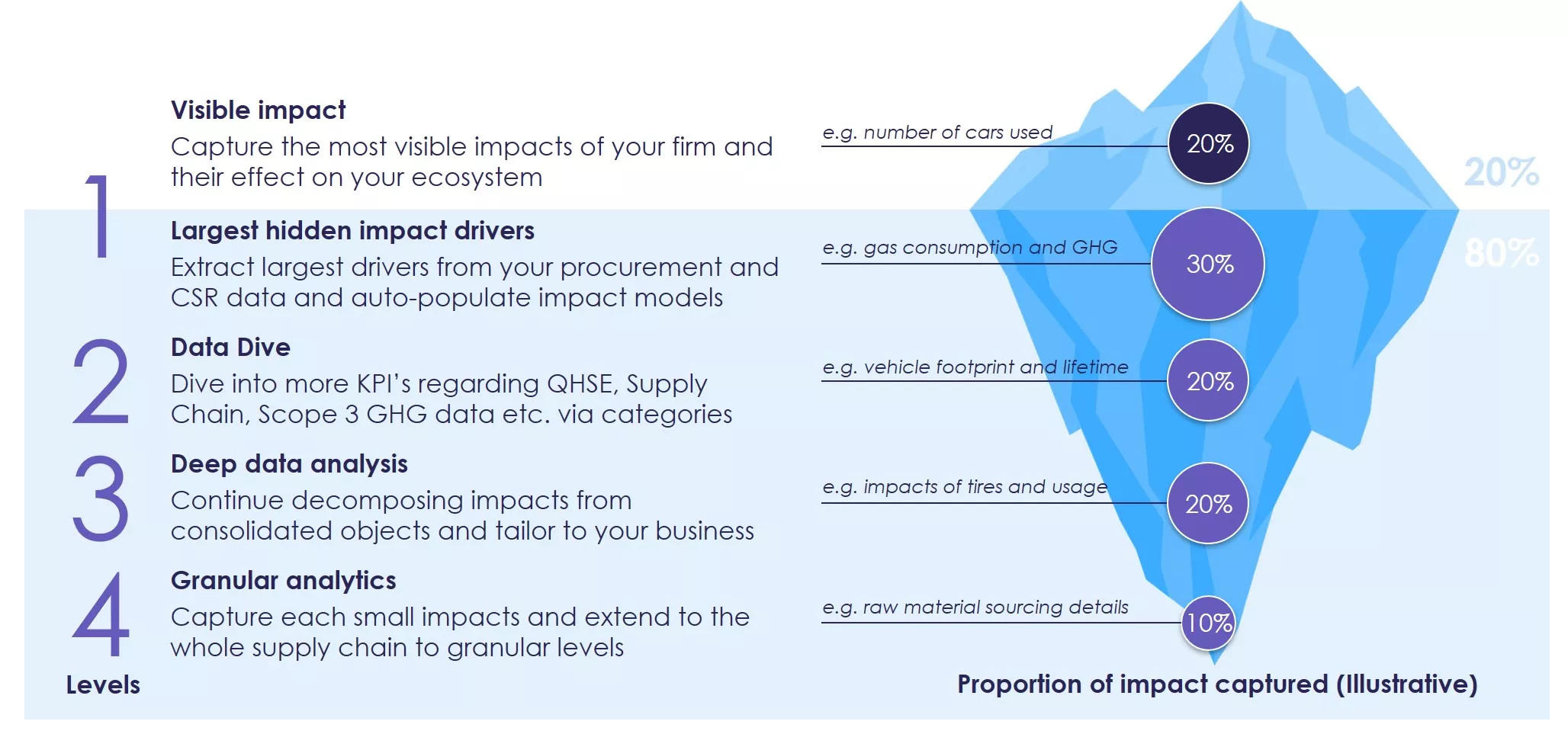
Step 1: Screening Using Impact Analysis Software
Using Impact analysis software to screen and determine the developments, events, policy changes or projects that will require a full or partial impact assessment.
Step 2: Investigating and establishing the relevant impacts
This step involves identifying the relevant potential impacts based on a number of factors and players such as
- Legal requirements
- Data and resources from experts
- Public involvement through use of impact assessment methods like questionnaires
- International conventions
These factors and impact assessment methodologies help identify the correct forecasted risks and benefits and help organizations to act accordingly.
Step 3: Assessment and evaluation of the impact and development of alternatives
Sometimes the correct or alternative route will involve a complete abandonment of the project or a diversion of the project to another area. These occurrences are not uncommon.
An evaluation of the appropriateness of the impact assessment and the mitigation is an important step in this entire process.
Ultimately, a detailed report of alternative solutions is required to be produced.
Step 4: Reporting and Reviewing of the EIA
After the preliminary studies and reports are completed, the Environmental Impact Statement (EIS) and the EIA report need to be presented to authorities both in the business and in the government in order for evaluation and reviewing to take place.
Step 5: Decision Making
If the EIS and the EIA both make an excellent case for the event to take place, then a tentative approval is given. This can be subject to varying modifications and conditions, depending on what the business is trying to achieve and what the legal regulations have approved.
This aspect includes the monitoring of the predicted impacts so that the business can mitigate and control the outcome.
2. Social impact assessment
Social impact is the effect of the proposed plan on people, groups, families and communities. A social impact assessment looks at the factors that can change communities and their environment if the proposed intervention takes place.
A social impact assessment report has to identify these impacts and factors in the following:
1. Regional and Local Institutional Structures
The report must factor in the positive and negative impacts of the proposed events or changes to the local communities.
2. The effect on the local population
There are several population characteristics that must be included in the assessment report. These include:
- Gender disparities in the area
- Racial or ethnic makeup and politics
- Population numbers
- Economic status
3. Current community structures and resources
Community resources differ from place to place but in general most community structures address housing and services. The social impact assessment has to factor in these issues during investigation.
4. Political Authority
All proposed changes in any area or region need to be in line with the applicable laws. And assessments must factor in the power dynamics that are at play and the shift that could occur should the change come to pass.
5. Families
At the core of any society is the family unit. The ripple effects of any changes that occur in business can be felt right down to the youngest members of society.
Business decisions impact people’s daily lives and social impact assessments have a bearing on:
- Family life, structures, characteristics, networks and perceptions
- The health and safety of families in the area (think of the Chernobyl Nuclear Disaster)
- Employment and Services
3. Business impact assessment
We have dealt with this in detail before in this guide, but let us quickly recap.
There are events and actions that can cause a disruption to business operations and finances. Some events are good because they foster growth and development, others are not and could lead to the business dying.
Proper planning is the only way to try to mitigate this risk, and this is where business impact assessment comes in.
An excellent business impact analysis will answer the following questions:
- What? What will the change be, and what processes need modification?
- Who? Who will be affected by the change?
- When? When will the foreseen event occur?
- How? How to handle the impact in the most effective way.
The areas where businesses are most likely to see an impact should there be a disruption are:
- In people, whether its local communities or employees
- Technology
- In the organization’s processes and policies
- In the company’s business strategy
- In the organization itself as a whole
4. Economic impact assessment
Economic impact analysis is an essential impact assessment tool that provides an in-depth look into the impact of business operations and decisions on the economy. This can be on a small scale like the local economy or a larger scale such as the global economy.
Factors to consider are:
- Job creation
- Overall profits
- Revenue in the area or country
- Wages
An economic impact analysis also acts as a measure of the success that business decisions have had. This analysis requires imploring tactics that use impact analysis software to collect data that can be utilized in this assessment
There are three key types of economic factors or impacts that an assessment will look into. These are:
- Direct Impacts
- Indirect Impacts
- Induced Impacts
When a business includes economic impact assessment as part of its business impact analysis strategy from the beginning, it will help formulate better decision making and ensure more profitability.
Some benefits of this analysis are:
- You can understand the financial effects of any change
- You can effectively decide on the best way to allocate resources
- Long-term planning is made easier
- Businesses can pitch their ideas, and projects better if they understand their impact
- You can understand the full picture
5. Human impact assessment
Human impact assessment involves the analysis of the consequences of certain decisions on the health and welfare of the people most affected. It is the humanization of corporate decision making.
It takes the following steps to assess the impact on human welfare and health:
- Screening and Scoping
- Researching and gaining information
- Describing alternatives
- Identifying all relevant impacts
- Looking for and identifying alternatives
- Reporting and Monitoring
6. Corporate Social Responsibility (CSR) Impact assessment
We cannot leave CSR out of the equation. It forms part of the business impact analysis methods that every business should implement.
Globalization has brought to the forefront the concept of shared value. And organizations have to assess the impact of their decisions and of certain events on their CSR obligations and duties.
Steps and Tools to conduct impact assessment
Impact assessment techniques
Though a complicated process, producing an impact assessment report is not very difficult.
You can adapt the impact assessment techniques and steps to suit any business in any market.
The procedure for performing an impact assessment has to have the following:
- Definition of the extent of the proposed changes
- Comparison of the differences between the proposed changes and the original state of affairs
- Focus on those key differences
- Identification, sorting, and categorization of all the foreseen and predicted impacts
- Decision making using the data presented
We can break it down further by looking at the following steps:
Step 1: Select the Project or Projects
The assessments need to be carried out on a specific project, program or plan. The first step is to identify what your business needs an assessment of.
A budget has to be developed and allocated because the acquisition of quality information needs a bit of money.
Step 2: Evaluate the feasibility of the Impact assessment
This step is crucial in the impact assessment methodology. The relevance of the impact assessment in the initial stages is essential.
The team conducting the evaluation will need to decide what the project is planning to do, over what extent of time and with which expected outcomes, investment and impact. Moreover, there has to be a consultation with the affected stakeholders and with the general public (for certain projects)
This impact evaluation stage has to have clear findings because the crux of the impact assessment plan rests on passing this stage.
Step 3: Prepare a Research Plan
The research plan is the first comprehensive impact assessment report that has to be developed. It is a draft of the final project. It should showcase the steps that the analysis is going to take to achieve an outcome.
Whether the outcome is positive or negative is irrelevant. This research plan should have the following:
- Problem definition
- Policy objectives and their definitions
- Identification and development of policy options
- Analysis of the impacts
- Comparison of policy options or alternatives and ultimately a recommendation for the best
- Developing and defining monitoring measures.
Methods Used for Impact Analysis
Typically, the best approach is to use the following impact assessment methodologies:
- Scoping or checklists
- Qualitative analysis; developing focus groups
- Quantitative analysis
- Identifying and describing alternatives for example cost-benefit analysis
- Data gathering by questionnaires, consultations and surveys
- Data presentation
- Monitoring and evaluation
Impact Assessment Framework
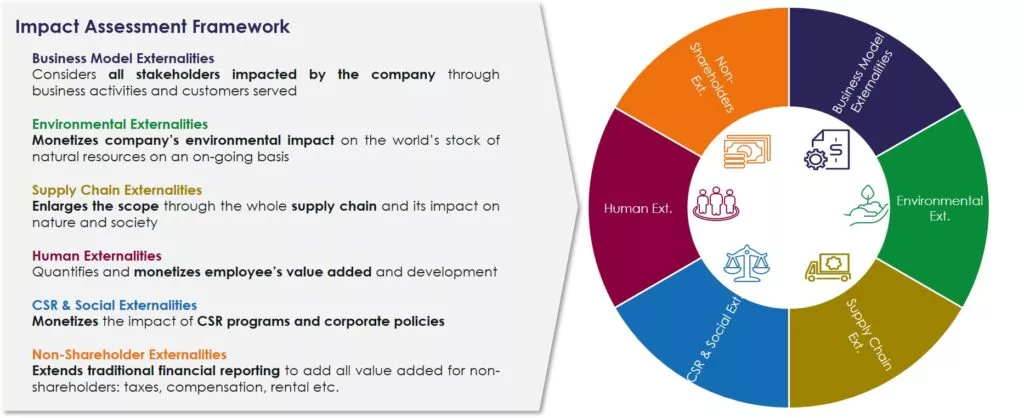
In developing a proper impact assessment framework, the important thing to remember is that it has to be as detailed as possible.
The process of conducting an impact assessment is made up of three components, which are:
- Impact Framework
- Assessment Results
- Performance Evaluation.
An Impact assessment framework is a detailed outlined a process that is meant to explain the following:
- Your business’s reason for wanting to develop and measure the impact of a certain event
- The impact assessment report, outcomes, forecast, inputs and predictions
- The organization’s mission statement, vision and goals in relation to the proposal
- The design of the program, policy, business plan etc.
- Theory of change which is essentially a detailed description and illustration of how and why the predicted change can occur in that specific manner in that particular context
- How the impact is going to be measured
- The standards and formula used
- The tools used such as surveys questionnaires, impact assessment software
- The source of the data and the resources used
Do's and Don'ts of Impact Assessment
- Facilitate the development of a theory of change that is detailed and comprehensive enough to avoid confusion. A clear direction is a plus for impact assessment
- Have realistic expectations about what is in your control and what is not. Knowing your limit is essential
- Work to build impact assessment into every current planning, monitoring, review and evaluation processes.
- Get all stakeholder’s input throughout the impact assessment process, as this will prevent unnecessary conflict or delays
- Ensure that you pay attention to the people on the ground. They know exactly how your business is going to impact and be impacted
- Establish an entrepreneurial culture in your organization this will foster outstanding problem-solving skills
- Do not shy away from impact assessment
- Be concerned with the terminology because various experts differ. As long as your assessment is detailed and concise, then there should be no issues
- Implement complex tools and methodologies in your impact assessment. It will end up confusing everyone. Unless you are an expert or you are under the guide of an expert
- Ignore the differences highlighted by the human impact assessment. Do not treat the local communities as one entity. The different groups will be impacted in various ways
- Ignore the findings from your impact assessment report
- Use one method or one type of the impact assessment categories. They must all be considered together otherwise the report is hollow
- Carry out an impact assessment without proper objectives and directions.
The bottom line is that impact assessments should be part of normal business practice. A comprehensive business analysis plan that incorporates impact assessment tools, methodologies, and techniques is one worth having.
Frequently Asked Question (FAQ)
What are the 4 types of impact assessment?
There are 4 main types of impact assessment:
- Environmental Impact Assessment (EIA): Focuses on assessing the potential environmental effects of proposed projects, such as construction or infrastructure development.
- Social Impact Assessment (SIA): Evaluates the social consequences and implications of projects, including impacts on communities, culture, and quality of life.
- Health Impact Assessment (HIA): Examines the potential health-related effects of policies, programs, or projects on communities and individuals.
- Economic Impact Assessment (EcIA): Analyzes the economic consequences of projects or policies, including effects on employment, income, and economic growth.
What is actual purpose of impact assessment?
The primary goal of impact assessment is to assess the potential advantages and drawbacks. These advantages or drawbacks are of a proposed project, policy or program. This includes the environment, society, health and economy. These assessments seek to provide information to decision makers, stakeholders and public regarding the repercussions of a specific action. This also enables well informed decision making and the formulation of strategies to reduce side effects.
How is impact assessment done?
Impact assessment is typically carried out through a systematic and structured process, which includes the following key steps:
- Scoping: Defining the boundaries and objectives of the assessment.
- Baseline Data Collection: Gathering data on the existing conditions in the affected areas.
- Impact Prediction: Identifying and predicting potential impacts based on the proposed project or policy.
- Impact Evaluation: Assessing the significance and magnitude of these impacts.
- Mitigation and Management: Developing strategies to mitigate adverse impacts and enhance positive ones.
- Reporting: Communicating findings and recommendations to decision-makers, stakeholders, and the public.
- Decision-Making: Providing information to inform decisions about whether to proceed with the project or policy.
What is impact assessment in EIA?
Impact assessment within the Environmental Impact Assessment (EIA) process is a vital element. It encompasses evaluation of potential environmental repercussions associated with a proposed project. This assessment entails the identification, prediction and evaluation of effects on various environmental facets. This includes air quality, water resources, biodiversity and land use. The objective is to ensure comprehensive examination of project environmental consequences. The implementation of suitable measures to mitigate adverse impacts and safeguard the environment.
What are the 5 types of impacts?
In various forms of impact assessments, the following five types of impacts are typically evaluated:
- Eco-Fluctuations: These span the influence on the natural world, affecting everything from the air we breathe to the delicate balance of water, soil, plant life, wildlife, and entire ecosystems.
- Community Ripples: This delves into how the project resonates with society, impacting the very fabric of communities, their structures, cultural expressions, and the well-being of individuals who call them home.
- Economic Ripples: Here, we dive into the financial currents, exploring how the project might create waves in employment, income levels, economic growth, and the allocation of financial resources.
- Wellness Echoes: This focuses on the potential reverberations through the health landscape, assessing how the project might influence the physical and mental well-being of individuals and the communities they belong to.
- Collateral Impact Quilt: Picture this as the patchwork of effects stitched together over time, as we consider how multiple projects or activities interlace and create a dynamic tapestry of change within the same environment or community.
What are the 8 principles of impact assessment?
The eight key principles of impact assessment include:
- Holistic Approach: Considering the interrelationships among environmental, social, economic and health impacts.
- Transparency: Ensuring that assessment process and findings are open and accessible to all the stakeholders.
- Inclusivity: Involving affected communities and stakeholders in the assessment process.
- Scientific Rigor: Applying sound scientific methods and data in impact assessment.
- Predictive Capability: Making informed predictions about potential impacts.
- Cumulative Effects Assessment: Evaluating the combined effects of multiple projects or actions.
- Adaptive Management: Adjusting strategies based on new information or changing circumstances.
- Mitigation and Enhancement: Developing measures to mitigate adverse impacts and enhance positive ones.
What are the 4 A's of impact?
The four A’s of impact assessment are:
- Assessment: The systematic process of evaluating potential impacts.
- Anticipation: Identifying and predicting impacts before they occur.
- Avoidance: Strategies to prevent or minimize adverse impacts.
- Adaptation: Adjusting plans and actions to address unforeseen impacts or changing circumstances.
What are the 5 principles of impact?
The five key principles of impact assessment are:
- Interconnectedness: Recognizing that impacts are often interrelated and considering their cumulative effects.
- Precaution: Exercising caution when uncertainties exist about potential impacts, especially when dealing with irreversible consequences.
- Participation: Involving affected communities and stakeholders in decision-making and impact assessment processes.
- Sustainability: Ensuring that development and actions do not compromise well being of future generations.
- Holism: Taking comprehensive view that encompasses environmental, social, economic, and health aspects when assessing impacts.
What are some common tools and methods used in impact assessment?
Impact assessments utilize various tools and methods, including:
- Environmental Impact Statements (EIS): Comprehensive documents outlining environmental impacts and mitigation measures for large-scale projects.
- Social Surveys: Gathering data through questionnaires and interviews to assess social impacts.
- Economic Models: Analyzing economic impacts using models to estimate job creation, GDP growth, and fiscal implications.
- Health Impact Modeling: Assessing health impacts by modeling factors like air quality, exposure to pollutants, and disease prevalence.
- Stakeholder Consultations: Engaging with stakeholders to gather their insights and concerns.
How climate change impacts assessment differ from other types of impact assessment?
Climate change impact assessment specifically focuses on evaluating the effects of climate change on various systems, including the environment, society, and the economy. It differs from other impact assessments in that it:
- Considers long-term changes in climate patterns.
- Examines the vulnerability of systems to climate change.
- Assesses adaptation and mitigation strategies to address climate-related impacts.
- Incorporates climate models and scenarios into the assessment process.
What are some examples of successful impact assessments leading to positive outcomes?
Successful impact assessments have led to positive outcomes in various fields:
- Environmental Conservation: EIA for protected areas has preserved valuable ecosystems.
- Urban Planning: SIA in urban projects has improved living conditions for marginalized communities.
- Public Health: HIA has informed policies that reduced air pollution and improved public health.
- Economic Development: EcIA has guided investments in industries that boost local economies.
- Sustainable Agriculture: Assessments have promoted sustainable farming practices and biodiversity conservation.
How do governments use impact assessments in policy development?
Governments use impact assessments to:
- Make informed policy decisions based on potential consequences.
- Ensure policies align with environmental, social, and economic goals.
- Identify regulatory measures and standards to mitigate negative impacts.
- Engage with stakeholders and the public to gather input.
- Evaluate policy effectiveness over time and make necessary adjustments.
What are the ethical considerations in impact assessments?
Ethical considerations in impact assessments include:
- Equity: Ensuring that impacts do not disproportionately affect vulnerable or marginalized communities.
- Informed Consent: Obtaining informed consent from affected parties before conducting assessments.
- Transparency: Providing transparent information about assessment processes, findings, and potential conflicts of interest.
- Accountability: Holding individuals and organizations accountable for their actions based on assessment outcomes.
Environmental Responsibility: Acting responsibly to protect the environment and future generations.
How can impact assessments contribute to sustainable development goals?
Impact assessments can contribute to sustainable development goals by:
- Identifying opportunities to promote economic growth without compromising environmental or social well-being.
- Assessing the social inclusivity and equity of development projects.
- Evaluating the impact of policies and projects on clean energy, climate action, and responsible consumption.
- Promoting responsible land use, biodiversity conservation, and the protection of ecosystems.
What are the key challenges in conducting impact assessments?
Some key challenges in conducting impact assessments include:
- Data Availability: Accessing accurate and up-to-date data for assessments.
- Predicting Long-term Impacts: Anticipating and modeling long-term consequences accurately.
- Complexity: Dealing with the interrelatedness of impacts and cumulative effects.
- Resource Constraints: Limited budgets and resources for comprehensive assessments.
- Stakeholder Engagement: Ensuring meaningful engagement of diverse stakeholders in the process.